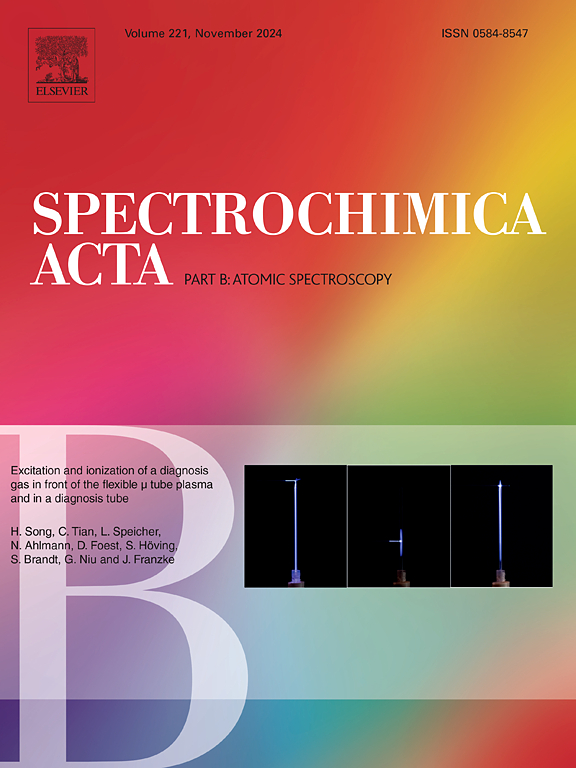Towards real-time calibration-free LIBS supported by machine learning
IF 3.2
2区 化学
Q1 SPECTROSCOPY
引用次数: 0
Abstract
Calibration-Free Laser-Induced Breakdown Spectroscopy (CF-LIBS) enables multi-elemental quantification without needing standards. This type of approach can be used to analyze complex samples containing traces or gradients of species. This type of diagnosis requires a high level of expertise, and is cumbersome to set up. These constraints limit its application to field diagnostics. Using the MERLIN generalized radiative transfer code, we are able to generate a diversified emission database with no dimensioning limitations. We show that training a convolutional residual network with such a database enables the quantification of 9 species, as well as evaluation of electron density and temperature, without any prior expertise at a rate greater than 10 Hz. The accuracy of this innovative method depends solely on the basic spectroscopic data (emission probabilities and Stark parameters), regardless of the thermodynamic conditions of the laser-induced plasma, as long as it is in Local Thermodynamic Equilibrium (LTE).

迈向由机器学习支持的实时无校准LIBS
无需校准的激光诱导击穿光谱(CF-LIBS)无需标准即可实现多元素定量。这种方法可用于分析含有物种痕迹或梯度的复杂样品。这种类型的诊断需要高水平的专业知识,并且设置起来很麻烦。这些限制限制了其在现场诊断中的应用。使用MERLIN广义辐射传输代码,我们能够生成一个没有尺寸限制的多样化发射数据库。我们表明,用这样的数据库训练卷积残差网络,可以在没有任何先前的专业知识的情况下,以大于10 Hz的速率对9种物质进行量化,以及对电子密度和温度进行评估。这种创新方法的准确性仅取决于基本光谱数据(发射概率和Stark参数),而不考虑激光诱导等离子体的热力学条件,只要它处于局部热力学平衡(LTE)。
本文章由计算机程序翻译,如有差异,请以英文原文为准。
求助全文
约1分钟内获得全文
求助全文
来源期刊
CiteScore
6.10
自引率
12.10%
发文量
173
审稿时长
81 days
期刊介绍:
Spectrochimica Acta Part B: Atomic Spectroscopy, is intended for the rapid publication of both original work and reviews in the following fields:
Atomic Emission (AES), Atomic Absorption (AAS) and Atomic Fluorescence (AFS) spectroscopy;
Mass Spectrometry (MS) for inorganic analysis covering Spark Source (SS-MS), Inductively Coupled Plasma (ICP-MS), Glow Discharge (GD-MS), and Secondary Ion Mass Spectrometry (SIMS).
Laser induced atomic spectroscopy for inorganic analysis, including non-linear optical laser spectroscopy, covering Laser Enhanced Ionization (LEI), Laser Induced Fluorescence (LIF), Resonance Ionization Spectroscopy (RIS) and Resonance Ionization Mass Spectrometry (RIMS); Laser Induced Breakdown Spectroscopy (LIBS); Cavity Ringdown Spectroscopy (CRDS), Laser Ablation Inductively Coupled Plasma Atomic Emission Spectroscopy (LA-ICP-AES) and Laser Ablation Inductively Coupled Plasma Mass Spectrometry (LA-ICP-MS).
X-ray spectrometry, X-ray Optics and Microanalysis, including X-ray fluorescence spectrometry (XRF) and related techniques, in particular Total-reflection X-ray Fluorescence Spectrometry (TXRF), and Synchrotron Radiation-excited Total reflection XRF (SR-TXRF).
Manuscripts dealing with (i) fundamentals, (ii) methodology development, (iii)instrumentation, and (iv) applications, can be submitted for publication.

 求助内容:
求助内容: 应助结果提醒方式:
应助结果提醒方式:


